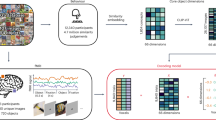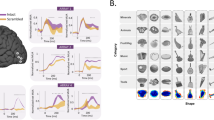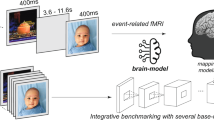Abstract
Various experimental approaches, using static 2D canonical views of living and non-living entities indicate that knowledge representations of these categories are distinct. In a series of experiments a Kohonen self organizing feature map was trained to recognise 2D digitised images. As a result, images of animals and musical instruments were represented within a shared set of processing units, which suggests that they are visually crowded categories, unlike clothing and furniture. These results are in keeping with those from other experimental approaches. Thus, it would appear that the simple interplay between a SOM and 2D images provides a valuable model of one route in visual object recognition.
Access this chapter
Tax calculation will be finalised at checkout
Purchases are for personal use only
Preview
Unable to display preview. Download preview PDF.
Similar content being viewed by others
References
Caramazza A. (1998) The interpretation of semantic category-specific deficits: what do they reveal about the organization of conceptual knowledge in the brain ? Neurocase, 4, 265–272.
Behl-Chadha, G. (1996) Basic-level and superordinate-like categorical representations in early infancy. Cognition, 60, 105–141.
French, R. M. & Mareschal, D. (1998) Could category specific semantic deficits reflect differences in the distributions of features within a unified semantic memory ? In Proceedings of the Twentieth Annual Cognitive Science Society Conference. NJ:LEA. 374–379
Rosch, E. (1975) Cognitive representations of semantic categories. Journal of Experimental Psychology: General, 104, 192–233.
Tanaka, K. (1996) Inferotemporal cortex and object vision. Annual Review of Neuroscience, 19, 109–139.
Logothetis, N. K. & Sheinberg, D. L. (1996) Visual Object Recognition. Annual Review of Neuroscience, 19, 577–621.
Warrington, E. K. & McCarthy, R. A. (1987) Categories of knowledge: Further fractionations and an attempted integration. Brain, 110, 1273–1296.
McRae, K., de Sa, V. R., and Seidenberg, M.S. (1997) On the nature and scope of featural representations of word meaning. Journal of Experimental Psychology: General,126, 99–130.
Gaffan, D., and Heywood, C. A. (1993) A spurious category-specific visual agnosia for living things in normal human and non human primates. Journal of Cognitive Neuroscience, 5, 118–128.
Yamane, S., Kaji, S., Kawano, K. (1988) What facial features activate face neurons in the inferotemporal cortex of the monkey? Exp. Brain Res., 139, 209–214.
Gainotti, G., Silveri M. C., Daniele, A., Giustolisi, L (1995) Neuroanatomical correlates of category-specific semantic disorders: a critical survey. Memory, 3, 247–264.
Schyns, P. G. (1991) A modular neural network model of concept acquisition. Cognitive Science, 15, 461–508.
Battig, W. F., & Montague, W. E. (1969) Category norms for verbal items in 56 categories: A replication and extension of the Connecticut category norms. Journal of Experimental Psychology, 80, 1–146.
Snodgrass, J. G., & Vanderwart, M. (1980) A standardised set of 260 pictures: Norms for name agreement, image agreement, familiarity, and visual complexity. Journal of Experimental Psychology: Human Learning&Memory, 6, 174–215.
Palmer, S. E., Rosch, E., & Chase, P. 91981) Canonical perspective and the perception of objects. In Long, J. & Baddeley, A. (Eds.) Attention and Performance Vol IX, 131–151, Erlbaum.
Kohonen, T. (1988) Self-Organisation and Associative Memory. Berlin: Springer-Verlag.
Kohonen, T and Hari, R. (1999) Where the abstract feature maps of the brain might come from. TINS, 22, 135–139.
Gale, T. M., Done, D. J. and Frank, R. J. Visual crowding and category specific deficits for pictorial stimuli: A neural network model. Cognitive Neuropsychology (in press).
Clark, A. (1997) The Dynamical Challenge. Cognitive Science, 21, 461–481.
Forde, E. M. E., Francis, D., Riddoch, M. J., Rumiati, R. J. and Humphreys, G. W. (1997) On the links between visual knowledge and naming: A single case study of a patient with a category-specific impairment for living things. Cognitive Neuropsychology, 14, 403–458.
Humphreys, G. W., Riddoch, M. J., and Quinlan, P. T. (1988) Cascade processes in picture identification. Cognitive Neuropsychology, 5” 67–103.
Farah, M.J., Meyer, M. M., and McMullen, P. A. (1996) The living/non-living dissociation in not an artefact: Giving an a-priori implausible hypothesis a strong test. Cognitive Neuropsychology, 13, 137–154.
Kurbat M. A. (1997) Can the recognition of living things really be impaired? Neuropsychologia, 35, 813–827.
Kurbat, M. A., & Farah, M. J. (1998) Is the category-specific deficit for living things spurious? Journal ofCognitive Neuroscience, 10,355–361.
Humphreys, G. W., Lamote, C., & Lloyd-Jones, T. J. (1995) An interactive activation approach to object processing: Effects of structural similarity, name frequency, and task in normality and pathology. Memory, 3, 535–586.
Dixon, M., Bub, D. N., & Arguin, M. (1997) The interaction of object form and object meaning in the identification performance of a patient with category-specific visual agnosia. Cognitive Neuropsychology, 14, 1085–1130.
Parkin, A.J., and Stewart, F. (1993) Category-specific impairments? No. A critique of Sartori et al. Quarterly Journal of Experimental Psychology, 46A, 505–509.
Editor information
Editors and Affiliations
Rights and permissions
Copyright information
© 2001 Springer-Verlag London
About this paper
Cite this paper
Done, J., Gale, T.M., Frank, R.J. (2001). Visual Crowding and Category-Specific Deficits: a Neural Network Model. In: French, R.M., Sougné, J.P. (eds) Connectionist Models of Learning, Development and Evolution. Perspectives in Neural Computing. Springer, London. https://doi.org/10.1007/978-1-4471-0281-6_17
Download citation
DOI: https://doi.org/10.1007/978-1-4471-0281-6_17
Publisher Name: Springer, London
Print ISBN: 978-1-85233-354-6
Online ISBN: 978-1-4471-0281-6
eBook Packages: Springer Book Archive




